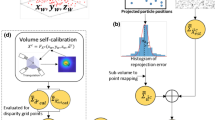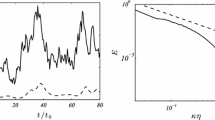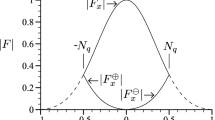Abstract
The uncertainty of any measurement is the interval in which one believes the actual error lies. Particle image velocimetry (PIV) measurement error depends on the PIV algorithm used, a wide range of user inputs, flow characteristics, and the experimental setup. Since these factors vary in time and space, they lead to nonuniform error throughout the flow field. As such, a universal PIV uncertainty estimate is not adequate and can be misleading. This is of particular interest when PIV data are used for comparison with computational or experimental data. A method to estimate the uncertainty from sources detectable in the raw images and due to the PIV calculation of each individual velocity measurement is presented. The relationship between four error sources and their contribution to PIV error is first determined. The sources, or parameters, considered are particle image diameter, particle density, particle displacement, and velocity gradient, although this choice in parameters is arbitrary and may not be complete. This information provides a four-dimensional “uncertainty surface” specific to the PIV algorithm used. After PIV processing, our code “measures" the value of each of these parameters and estimates the velocity uncertainty due to the PIV algorithm for each vector in the flow field. The reliability of our methodology is validated using known flow fields so the actual error can be determined. Our analysis shows that, for most flows, the uncertainty distribution obtained using this method fits the confidence interval. An experiment is used to show that systematic uncertainties are accurately computed for a jet flow. The method is general and can be adapted to any PIV analysis, provided that the relevant error sources can be identified for a given experiment and the appropriate parameters can be quantified from the images obtained.

















Similar content being viewed by others
Abbreviations
- \(\Updelta t\) :
-
Time difference between images
- \(\Updelta x\) :
-
Particle displacement between images
- β:
-
Systematic uncertainty estimate
- D true :
-
The true displacement
- N I :
-
Number particles within an interrogation region
- r :
-
The random uncertainty
- r ave :
-
The average displacement computed
- r high :
-
The upper random uncertainty estimate
- r low :
-
The lower random uncertainty estimate
- u :
-
The x component of velocity
- \(U_{\Updelta t}\) :
-
Uncertainty of the time difference
- \(U_{\Updelta x}\) :
-
Uncertainty of the displacement
- U + r :
-
The upper combined uncertainty limit
- U − r :
-
The lower combined uncertainty limit
- u true :
-
The true x component of velocity
- v :
-
The y component of velocity
References
Adrian RJ (2005) Twenty years of particle image velocimetry. Exp Fluids 39:159–169
Adrian RJ, Westerweel J (2011) Particle image velocimetry, Vol I. Cambridge University Press, New York
ASME (2009) Standard for verification and validation in computational fluid dynamics and heat transfer. Tech. rep., ASME, ASME V&V 20-2009
Coleman HW, Steele WG (2009) Experimentation, validation, and uncertainty analysis for engineers, 3rd edn. Wiley, Hoboken, NJ
Eckstein AC, Vlachos PP (2009a) Assessment of advanced windowing techniques for digital particle image velocimetry (DPIV). Meas Sci Tech 20:075,402
Eckstein AC, Vlachos PP (2009b) Digital particle image velocimetry (DPIV) robust phase correlation. Meas Sci Tech 20:055,401
Eckstein AC, Charonko J, Vlachos P (2008) Phase correlation processing for DPIV measurements. Exp Fluids 45:485–500
Gui L, Wereley ST (2002) A correlation-based continuous window-shift technique to reduce the peak-locking effect in digital piv image evaluation. Exp Fluids 32(4):506–517
Keane RD, Adrian RJ (1992) Theory of cross-correlation analysis of piv images. Appl Sci Res 49(3):191–215
LaVision (2006) Davis 7.2. http://www.lavision.de/en, laVision GmbH, Göttingen, Germany
Lazar E, DeBlauw B, Glumac N, Dutton C, Elliott G (2010) A practical approach to piv uncertainty analysis. In: AIAA Aerodynamic measurement technology and ground testing conference, paper number AIAA 2010-4355
Meinhart CD, Wereley ST, Santiago JG (2000) A PIV algorithm for estimating time-averaged velocity fields. J Fluids Eng Trans ASME 122(2):285–289. doi:10.1115/1.483256
Nobach H, Bodenschatz E (2009) Limitations of accuracy in PIV due to individual variations of particle image intensities. Exp Fluids 47(1):27–38. doi:10.1007/s00348-009-0627-4
Ogawa A (1993) Vortex flow. CRC Press, Boca Raton, FL
Olsen MG (2009) Directional dependence of depth of correlation due to in-plane fluid shear in microscopic particle image velocimetry. Meas Sci Tech 20(1):015402. doi:10.1088/0957-0233/20/1/015402
PIV Uncertainty Workshop (2011) http://www.piv.usu.edu
Raffel M, Willert C, Kompenhans J (1998) Particle image velocimetry. Springer, Berlin
Scarano F (2002) Iterative image deformation methods in piv. Meas Sci Technol 13:R1–R19
Stanislas M, Okamoto K, Kaehler C (2003) Main results of the first international PIV challenge. Meas Sci Technol 14:R63–R89
Stanislas M, Okamoto K, Kahler CJ, Westerweel J (2005) Main results of the second international PIV challenge. Exp Fluids 39(2):170–191
Stanislas M, Okamoto K, Kaehler CJ, Westerweel J, Scarano F (2008) Main results of the third international PIV challenge. Exp Fluids 45:27–71
Timmins BH, Smith BL, Vlachos PP (2010) Automatic particle image velocimetry uncertainty quantification. In: Proceedings of ASME fluids engineering division summer meeting, paper number FEDSM-ICNMM2010-30724
Wereley ST, Meinhart CD (2001) Second-order accurate particle image velocimetry. Exp Fluids 31:258–268
Westerweel J (1997) Fundamentals of digital particle image velocimetry. Meas Sci Technol 8:1379–1392
Westerweel J (2008) On velocity gradients in piv interrogation. Exp Fluids 44(5):831–842
Westerweel J, Scarano F (2005) Universal outlier detection for PIV data. Exp Fluids 39:1096–1100
Westerweel J, Geelhoed PF, Lindken R (2004) Single-pixel resolution ensemble correlation for micro-piv applications. J Fluids Eng Trans ASME 37(3):375–384
White FM (1986) Fluid mechanics. McGraw Hill, New York
Willert CE, Gharib M (1991) Digital particle image velocimetry. Exp Fluids 10(4):181–193
Wilson BM (2012) Unsteady CFD validation and uncertainty quantification using PIV. PhD. dissertation, Utah State University
Acknowledgments
This work has been supported by the United States Department of Energy through the Idaho National Laboratory’s LDRD Project NE-156. BHT would like to thank Kyle Horne, John Charonko, and Satyapraksh Karri for their assistance.
Author information
Authors and Affiliations
Corresponding author
Appendix: Test velocity fields and synthetic image generation
Appendix: Test velocity fields and synthetic image generation
Using “Synthetic Images” based on known flow data (from analytical solutions or numerically computed flow fields) makes it possible to know the exact solution, and true error, for specific cases. A synthetic image is an artificial image of seed particles in a known velocity field. To generate these images, an algorithm was produced, which follows the method discussed in Raffel et al. (1998).
A particle image diameter (d τ) is specified for the image to be created. The intensity distribution of a specific particle can be computed based on a Gaussian laser sheet,
where I lp is the peak intensity and d l is the sheet thickness. As a result of using a gaussian laser sheet with finite thickness, particles distributed in the z-direction have variable peak intensity. The z location of the particle centers vary from 2σ to −2σ, where σ is the standard deviation of the beam intensity; similar to particle image diameter, the laser sheet width is 4σ. Once the peak particle intensity has been calculated, the particle intensity profile can be computed. The particles are assumed to produce a Gaussian light profile according to
where x 0 and y 0 are coordinates of the particle center. Equation 7 can be used to define the intensity contribution of a particle to the entire image; however, for this work, any values of I p < 1 × 10−8 are neglected. This simplification saves considerable computational time to generate the synthetic images. The particle intensity profile defined Eq. 7 can be integrated over the area of a pixel to determine that specific pixel’s intensity
The complete images are the sum of all the particle intensity profiles. The first image of the pair is generated with particles at random positions (x, y, and z) according to a uniform distribution. The particle location is then displaced according to a specified velocity field.
We generate five flows: uniform flow, constant gradient, Couette–Poiseuille flow between plates, Burger's vortex flow, and direct numerical solution (DNS) for a laminar separation bubble from the third PIV challenge (Stanislas et al. 2008).
A uniform velocity flow can be created by displacing all particles by the same specified magnitude for each velocity component. It can be expressed as
The linear velocity profile (constant gradient) is defined as
The combined Couette–Poiseuille flow is a laminar one-dimensional flow driven by a constant pressure gradient and moving upper wall with a no slip boundary condition at each wall. The flow field can be expressed as
where U is the velocity of the upper wall, and h is the half-distance between plates (White 1986). The velocity vector then becomes
A Burgers' vortex is a vortex model, which assumes the fluid is steady, axis-symmetric, with small axial gradients of physical quantities. The flow velocity is described by
where b is the radius of the vortex, and V rb and V θb are cylindrical components of velocity at r = b (Ogawa 1993). Converting to cartesian coordinates
Background noise was added to each image at three different levels. The first level is no noise. The second noise level is meant to approximate the actual noise level in the PCO Sensicam QE 12-bit CCD camera. To approximate the noise produced when recording images with this camera, 100 image pairs were acquired of air with no seed particles illuminated by a New Wave Research Solo PIV III ND-Yag Laser dual cavity laser. A histogram of the pixel intensities was generated to show the noise distribution. The histogram, shown in Fig. 18, has an x-axis normalized by the maximum pixel intensity (4,095), and the y-axis is normalized by the total number of pixels recorded. The normalized histogram was fitted with a normal distribution:
with average μ = 1.011e −2 and standard deviation σ = 5.96e −4. Random samples were taken from this normal distribution and added to each image to simulate the background noise of the PCO Sensicam. The third noise level is meant to approximate the noise of the Photron FastCam APX RS 10-bit CMOS camera in the same manner as the second noise case. The mean was found to be μ = 2.834e −3 and the standard deviation σ = 3.55e −3. Note that the addition of noise was found to have no important effect on the results in this paper and therefore are not included in the results.
Rights and permissions
About this article
Cite this article
Timmins, B.H., Wilson, B.W., Smith, B.L. et al. A method for automatic estimation of instantaneous local uncertainty in particle image velocimetry measurements. Exp Fluids 53, 1133–1147 (2012). https://doi.org/10.1007/s00348-012-1341-1
Received:
Revised:
Accepted:
Published:
Issue Date:
DOI: https://doi.org/10.1007/s00348-012-1341-1





